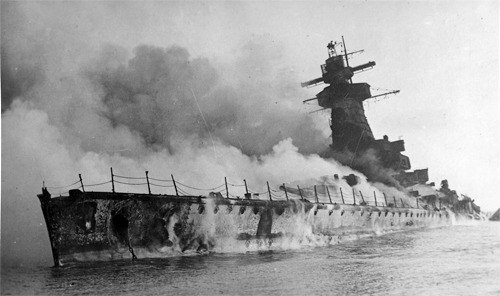Long before the Pearl Harbor attack on Dec. 7, 1941, there was a war going on, and while the United States wasn’t yet officially involved, its sailors saw a lot of action all over the world.
One of the most famous naval incidents of the early years of World War II was the case of the German pocket battle ship Graf Spee, which was being hounded by the English cruisers Ajax, Achley and Exeter. To find refuge, the German captain guided his ship into the port of Montivedo, Uruguay, a neutral country.
Harold John Shimer, 92, presently recovering at home in Anacortes from a stroke, was aboard the USS Helena, a CL-50 neutrality patrol protecting Uruguay and Argentina from the raging war. He may be the last man alive that had any involvement the Graf Spee incident.
The task of the Graf Spee, which became one of the most famous German warships of World War II, was to sink allied merchant ships. She sank nine such ship with no loss of life, as the German captain made sure the crews was taken to a prison ship before sinking their vessels. But pursuing English ships damaged the Graf Spee, forcing it into Montevideo Harbor.
The Americans followed the German ship into harbor and the men mingled, not yet being at war.
The fatal catch for the German captain was that the rules of war stated he could remain in the neutral port for only 72 hours, not enough time to repair the vessel as British ships waited outside the port. According to Wikipedia, the British spread the rumor that they had even more ships on the way to cut off any possible escape route.
The German captain, Hans Langsdorff, had to choose between surrendering his ship or making a run for it to almost certain death. A cable from Adolph Hitler told him to fight his way through to Argentina, using his remaining ammunition.
Instead, Langsdorff took the Graf Spree just outside the harbor, but rather than take part in a losing battle he scuttled the ship. He lost his ship but saved his men. Three days later he wrapped himself in the imperial flag and shot himself to death, presumably to show that he did not do what he did for fear of losing his own life.
Shimer’s 22-year career in the Navy was filled with adventure. He recalls watching the Gaspee go down. He met crew members as they came ashore. “We watched all of it,” he said from his home recently.
A photo shows Harold “Hal” John Shimer and two other Americans standing with some Graf Spee crew, arms slung over one another’s shoulders.
“The Germans spread out pretty well. We didn’t understand the language but they were humble and we had no demands upon them. They were free and we were free,” Shimer said.
He said the Germans stayed in South American to avoid the war. “They knew what the outcome would be,” he said.
The Helena moved on to the Pacific and was at Pearl Harbor on Dec. 7, 1941. It was hit by a Japanese torpedo, losing 23 men. But Shimer and the other surviving crew members fired back and were credited with saving the USS Pennsylvania, the flag ship of the fleet in drydock just forward of the Helena.
Following repairs, the Helena went on to win fame for sinking a number of Japanese ships, before being sunk herself by a submarine in 1943.
Shimer ended his naval career from Staff NAS Seattle in 1961 as a warrant officer.
Cecil Calavan, 87, is the youngest of eight Pearl Harbor survivors in the North Cascade Chapter 5 of the Pearl Harbor Survivors Association, for which he is vice president. He has his own tales to tell about World War II battles, but he prefers that Shimer’s story be told because it’s so rare.
“I think it’s unique,” Calavan said. “I think Hal is the last survivor of the Gas Spee incident, and I think he’s a fine man, but he’s on his last legs.”
Actually, Shimer recovered better than expected from his stoke. He’s back at home with his wife and attended a Flag Day ceremony in Anacortes in June.
Shimer surprised even himself by his stroke recovery. “Thank the Lord, I’m feeling pretty good,” said the old sailor.
Asked if he had any advice for modern sailors, many of whom he knows from trips at Whidbey Island Naval Air Station, he said, “Keep your chin up and do the best you can.”




